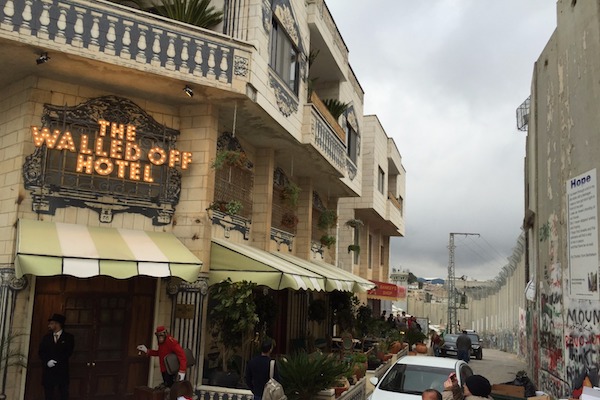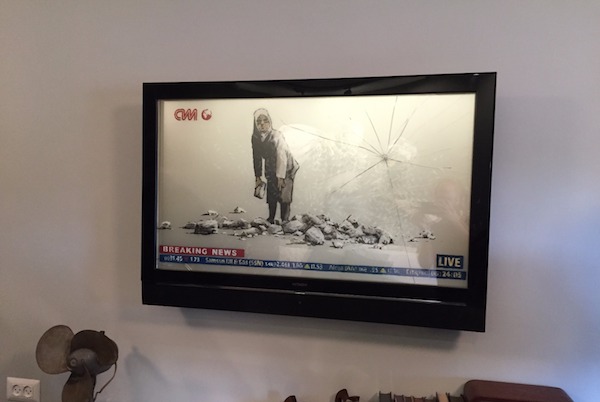Exit through the Checkpoint: Inside Banksy’s New Bethlehem Hotel
PALESTINE - ISRAEL, 13 Mar 2017
Haggai Matar | +972 – TRANSCEND Media Service
Every room overlooks the West Bank separation wall, the lobby features a Greek statue choking on teargas, and faux-security cameras dot the corridors. Welcome to “The Walled Off Hotel,” the new Bethlehem-based project from British street artist and enfant terrible Banksy.
3 Mar 2017 — It takes an unusual hotel proprietor to advertise their establishment as “the hotel with the worst view in the world.” But then Banksy, the British street artist renowned for his satirical and political graffiti, isn’t your average hotelier. With his name already well-established in Israel-Palestine thanks to his famous creations on the West Bank separation wall and in Gaza, Banksy has now opened “The Walled Off Hotel” (a pun on “Waldorf”) in Bethlehem, right next to the wall.
The hotel, which will only start receiving guests in two months’ time, was open on Friday to a select list of news outlets: CNN, the BBC, The Guardian, a few international news agencies — and Local Call and +972 Magazine. Banksy’s strap-line for his new venture is not inaccurate: from the dining room, as well as from each of the 10 guest rooms, there is a one view alone: the grey concrete slabs of the separation fence.
“It’s kind of a mix between the Mad Hatter’s tea party in Alice in Wonderland, and the house from ‘The Addams Family,’” muses Maayan Dak, a leftwing activist and my companion on the tour. And indeed, Banksy’s hotel — a business, art show and protest project rolled into one — does have the feel of a haunted house, at once terrible and magical.
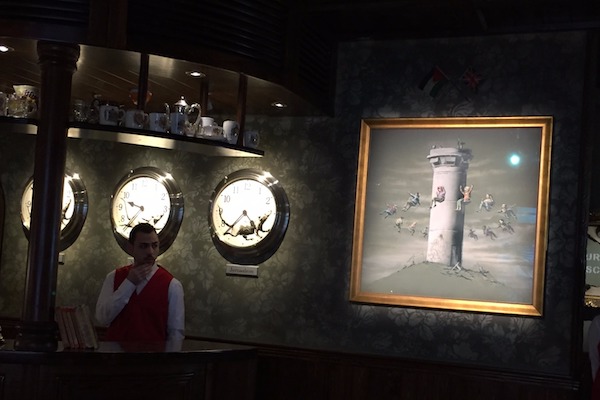
A member of staff next to a Banksy creation in The Walled Off Hotel, Bethlehem, March 3, 2017. (Haggai Matar)
Visitors to the hotel are welcomed at the entrance by a monkey-porter, one of whose suitcases has fallen open, its contents spilling onto the street opposite the separation wall. The lobby is decorated with works of art, all distortions of classic pieces: Turner-style paintings of the sea with lifebelts from refugees in the Mediterranean thrown in; a Greek-style statue choking on tear gas; a small portrait of Jesus with a the red dot of a sniper rifle sight on his forehead; a Vermeer-style farmhouse being bulldozed by a D-9 Caterpillar, and more.
Alongside all this, and throughout the hotel, typical Banksy motifs are on display: the rat, a protester throwing a bunch of flowers instead of a Molotov cocktail, slingshots, security cameras.
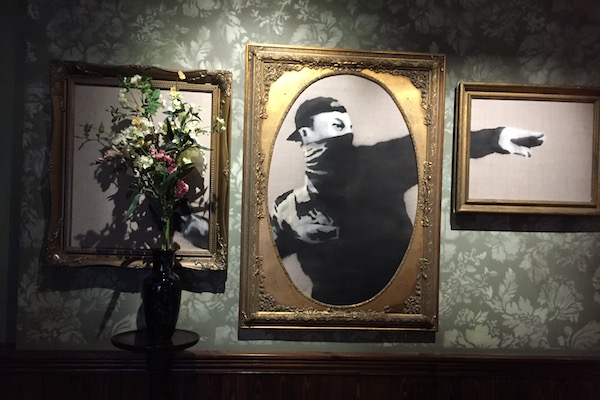
A version of Banksy’s famous protester piece, The Walled Off Hotel, Bethlehem, March 3, 2017. (Haggai Matar)
The hotel manager and a large team of staff, all Bethlehem residents, received visitors in the lobby. The space is styled after an English boutique hotel, with an old bookcase (which is in fact a hidden door that leads to the rooms), porcelain teacups and a self-playing piano. From there one can head to a trilingual museum about the conflict (to which Israelis and Palestinians are invited to contribute their own objects), to a gallery featuring an impressive collage of contemporary Palestinian art (which Banksy hopes will “open a new chapter in the history of Arabic art in general, and Palestinian art in particular”), and, of course, to the bedrooms.
Every room in the hotel has its own separate design, some of them by different artists (including Sami Musa from Ramallah and Dominique Pétrin from Canada). One room includes exposed concrete, which corresponds with the view of the separation wall. Another room is particularly colorful, while another has a triple bunkbed (formerly army property) for cash-strapped travelers. The top floor houses the presidential suite, with a large jacuzzi in the middle of the living room and a balcony from which one can see Jerusalem, beyond the wall.
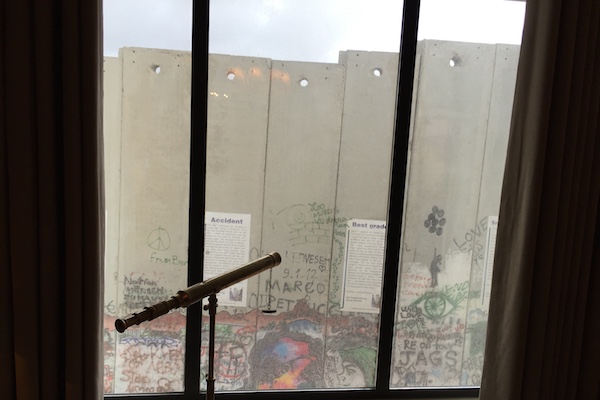
View of the separation wall from a room in The Walled Off Hotel, Bethlehem, March 3, 2017. (Haggai Matar)
Some of the rooms feature new Banksy creations (of which the standout is a painting showing a Palestinian and an Israeli soldier having a pillow-fight). As mentioned above, the separation wall can be seen from every room, and in addition to having to deal with the fake security cameras dotted throughout the hotel, guests must also contend with real cameras stationed along the barrier, which can swivel and observe them even when they’re indoors.
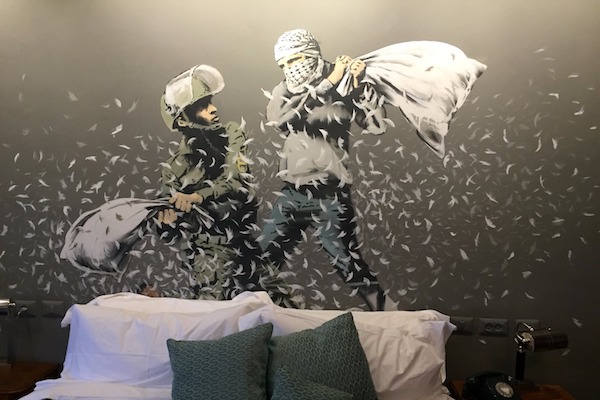
Banksy artwork showing an Israeli soldier and a Palestinian having a pillow fight, The Walled Off Hotel, Bethlehem, March 3, 2017. (Haggai Matar)
The overall experience at the hotel is a complex one: on the one hand, the art throughout the building is thrilling, and one encounters new creations on every corner. But at the same time there is something disturbing about Banksy’s artwork, especially when it’s opposite the separation wall and above dumpsters which haven’t been emptied (one wonders whether this is by design). And yet the rooms are comfortable and attractive, just as any hotel guest would want.
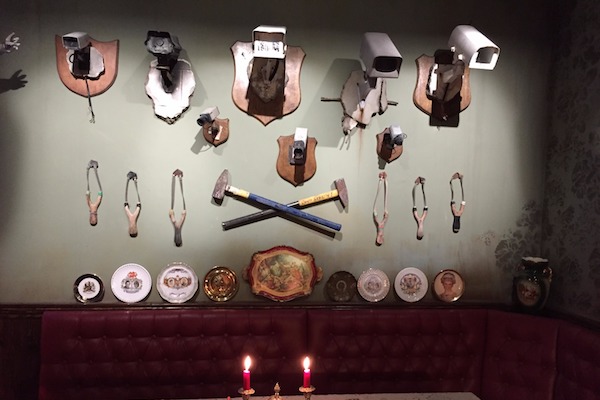
A wall featuring security cameras, slingshots, and other Banksy motifs, The Walled Off Hotel, Bethlehem, March 3, 2017. (Haggai Matar)
“It’s exactly one hundred years since Britain took control of Palestine and started re-arranging the furniture — with chaotic results,” wrote Banksy in a press release about his new project. “I don’t know why, but it felt like a good time to reflect on what happens when the United Kingdom makes a huge political decision without fully comprehending the consequences.”
Britain’s responsibility for our current situation, as far as Banksy sees it, is also expressed in the presence of a Lord Balfour doll at the entrance to the hotel’s museum. The doll is signing the famous Balfour Declaration, over and over.
For Jo Brooks, a PR specialist who has been working with Banksy for over a decade, it’s especially important that other Israelis will hear about the hotel and come and see it for themselves, even if just to walk around. Banksy also stated his wish for Israelis to visit his hotel and to learn more about the wall, and for local Palestinians to meet them and establish some kind of connection.
It’s not clear whether Banksy and his team have taken into account the view many Palestinians have of Israelis who visit cities under occupation (i.e. that they themselves are part of the occupation in action). They also have a thing or two to learn about the local politics here. And yet they undoubtedly have good intentions, the results are impressive, and the art is incredible.
At the end of the tour we left the hotel and went back past the mounds of garbage, the graffiti-covered separation wall, and the clutch of shops selling Banksy memorabilia (whose staff don’t yet know that Banksy himself has opened a hotel next door to them). We collected the car, and exited Bethlehem through the checkpoint.
______________________________
 Haggai Matar is an Israeli journalist and political activist. After writing for Ha’aretz and Ma’ariv (where he became chairman of the journalists’ union chapter), he is now the co-editor of Local Call, +972’s sister site in Hebrew. He was awarded the 2012 Anna Lindh Mediterranean Journalist Award for his +972 series on the separation wall.
Haggai Matar is an Israeli journalist and political activist. After writing for Ha’aretz and Ma’ariv (where he became chairman of the journalists’ union chapter), he is now the co-editor of Local Call, +972’s sister site in Hebrew. He was awarded the 2012 Anna Lindh Mediterranean Journalist Award for his +972 series on the separation wall.
This article was originally published in Hebrew on Local Call. Read it here.
Translated by Natasha Roth.
Join the BDS-BOYCOTT, DIVESTMENT, SANCTIONS campaign to protest the Israeli barbaric siege of Gaza, illegal occupation of the Palestine nation’s territory, the apartheid wall, its inhuman and degrading treatment of the Palestinian people, and the more than 7,000 Palestinian men, women, elderly and children arbitrarily locked up in Israeli prisons.
DON’T BUY PRODUCTS WHOSE BARCODE STARTS WITH 729, which indicates that it is produced in Israel. DO YOUR PART! MAKE A DIFFERENCE!
7 2 9: BOYCOTT FOR JUSTICE!
DISCLAIMER: The statements, views and opinions expressed in pieces republished here are solely those of the authors and do not necessarily represent those of TMS. In accordance with title 17 U.S.C. section 107, this material is distributed without profit to those who have expressed a prior interest in receiving the included information for research and educational purposes. TMS has no affiliation whatsoever with the originator of this article nor is TMS endorsed or sponsored by the originator. “GO TO ORIGINAL” links are provided as a convenience to our readers and allow for verification of authenticity. However, as originating pages are often updated by their originating host sites, the versions posted may not match the versions our readers view when clicking the “GO TO ORIGINAL” links. This site contains copyrighted material the use of which has not always been specifically authorized by the copyright owner. We are making such material available in our efforts to advance understanding of environmental, political, human rights, economic, democracy, scientific, and social justice issues, etc. We believe this constitutes a ‘fair use’ of any such copyrighted material as provided for in section 107 of the US Copyright Law. In accordance with Title 17 U.S.C. Section 107, the material on this site is distributed without profit to those who have expressed a prior interest in receiving the included information for research and educational purposes. For more information go to: http://www.law.cornell.edu/uscode/17/107.shtml. If you wish to use copyrighted material from this site for purposes of your own that go beyond ‘fair use’, you must obtain permission from the copyright owner.
Read more
Click here to go to the current weekly digest or pick another article:
PALESTINE - ISRAEL:
